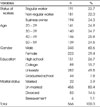2. Jo PK. The effect of the economic characteristics of single person households on the food service industry. Korean J Community Nutr. 2016; 21(4):321–331.
3. Oh YJ. Analysis of nutrients and food behaviors of eating alone according to increasing in single households. In : Proceedings of 2016 Spring Conference of the Korean Society of Community Nutrition; 2016 Jun 3; Seoul. p. 1–14.
4. Kim GS. The economic characteristics and implications of single households. Hyundai Research Institute;2015. 08. Report No. 654.
5. Kang EN, Lee MH. Single-person households in South Korea and their policy implication. Health Welf Policy Forum. 2016; 234:47–56.
6. Chung KH, Nam SH, Chung EJ, Lee JH, Lee YK, Kim JS, et al. Policy implications of changes in family structure: focused on the increase of single person households in Korea. Korea Institute for Health and Social Affairs;2012. 12. Report No. 2012-47-25.
7. Noh HJ. Social relationships of young single-person households. Health Soc Welf Rev. 2018; 38(2):71–102.
8. Byun MR, Choi JW, Park MJ, Lee HJ, Kim JA. A study on the policy of Seoul Metropolitan Government for single households. The Seoul Institute;2015. 02. Report No. 2014-ER-27.
9. Lee KA. A study on the direction of future consumer policies with the advent of one-person household era. J Consum Policy Stud. 2017; 48(2):61–85.
10. Jo PK. The effect of single person households on the food service industry. In : Proceedings of 2016 Spring Conference of the Korean Society of Community Nutrition; 2016 Jun 3; Seoul. p. 39–54.
13. Lee JY, Choi SK, Seo JS. Evaluation of the nutrition status and metabolic syndrome prevalence of the members according to the number of household members based on the Korea National Health and Nutrition Examination Survey (2013–2014). Korean J Community Nutr. 2019; 24(3):232–244.

14. Choi BB. Recognition and consumption of meal alone and processed food according to major of college students. Korean J Food Nutr. 2016; 29(6):911–922.

15. Lee Y, Cho W, Oh Y. Comparison of eating behavior between commensality and solo-eating of university students by BMI. Korean J Community Nutr. 2012; 17(3):280–289.

16. Yamaji T, Mikami S, Kobatake H, Tanaka K, Higashi Y, Kihara Y. Slow down, you eat too fast: fast eating associate with obesity and future prevalence of metabolic syndrome. In : Proceedings of 2017 American Heart Association's Scientific Sessions; 2017 Nov 14; Anaheim, CA. p. 136.
17. Lee KI, Hwang YJ, Ban HJ, Lim SJ, Jin HJ, Lee HS. Impact of the growth of single-person households on the food market and policy task. Korea Rural Economic Institute;2015. 10. Report No. R762.
18. Kang NY, Jung BM. Analysis of the difference in nutrients intake, dietary behaviors and food intake frequency of singleand non single-person households: The Korea National Health and Nutrition Examination Survey (KNHANES), 2014–2016. Korean J Community Nutr. 2019; 24(1):1–17.
19. Lee J, Shin A. Vegetable and fruit intake in one person household: The Korean National Health and Nutrition Examination Survey (2010~2012). J Nutr Health. 2015; 48(3):269–276.

20. Kim HJ. An analysis of household debt burden by householder's occupation. Soc Welf Policy. 2004; 20(1):109–132.
21. Kim JY, You SD. The effects of household characteristics on housing tenure choice and house type. House Stud Rev. 2013; 21(4):61–85.
22. Park KS, Kim MS. The impact of change in household living arrangements on the changes in poverty rate among elderly people in South Korea. Korean J Sociol. 2016; 50(1):221–253.
23. Lee YJ, Kwon MK, Baek HJ, Lee SS. Comparative analysis of food intake according to the family type of elderly women in Seoul area. J Nutr Health. 2015; 48(3):277–288.

24. An BM, Son JH. Analysis of metabolic syndrome in Korean adult one-person households. J Korean Public Health Nurs. 2018; 32(1):30–43.
26. Lee Y, Oh YJ, Cho W, Jo PK. Differences in solo eating perceptions and dietary behaviors of university students by gender. J Korean Diet Assoc. 2015; 21(1):57–71.

27. Kim MH, Kim H, Lee WK, Kim SJ, Yeon JY. Food habits and dietary behavior related to using processed food among male college students residing in dormitory and self-boarding in Gangwon. Korean J Community Nutr. 2013; 18(4):372–385.

28. Kim A. Effect of health behaviors, dietary habits, and psychological health on metabolic syndrome in one-person households among Korean young adults. J Digit Converg. 2018; 16(7):493–509.
29. Huh IS, Kim HS, Jo HK, Lim CS, Kim JS, Kim SJ. Instant noodle consumption is associated with cardiometabolic risk factors among college students in Seoul. Nutr Res Pract. 2017; 11(3):232–239.

30. Kim SY. Analysis of age, cohort and time effect on diversity of food consumption in Korean. J Rural Dev. 2010; 33(1):21–39.
31. Han JM, Lee YH. Impact of single-person household increment on consumption disbursement. KIET Mon Ind Econ. 2013; 6:22–31.
32. Jeong I, Kim HM. Korea one-person households report 2018. KB finance group research institute;2018. 10.
33. Rozman G. East Asian national identities: common roots and Chinese exceptionalism. Stanford, CA: Stanford University Press;2012. p. 1–256.
34. Kim JK. The factors affecting the level of awareness of life and happiness perceived by youth generation. Korea Soc Policy Rev. 2018; 25(3):209–245.
35. Koo S, Park K. Dietary behaviors and lifestyle characteristics related to frequent eating out among Korean adults. J Korean Soc Food Sci Nutr. 2013; 42(5):705–712.

36. Lee YM, Oh YJ, Cho WK, Jo PK. Differences in solo eating perceptions and dietary behaviors of university students by gender. J Korean Diet Assoc. 2015; 21(1):57–71.






 PDF
PDF ePub
ePub Citation
Citation Print
Print









 XML Download
XML Download